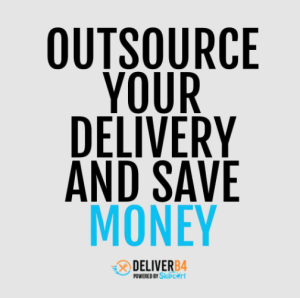Hiring an in-house fleet of drivers isn’t the only alternative for restaurants stressed by high fees from large third-party delivery providers. Through a new partnership, Skipcart and DeliverB4 are offering an alternative, outsourced delivery program that claims to save restaurants $2 or more per order.

Pointing to a recent NRA survey showing that 90 percent of restaurants are less profitable than before the pandemic, the newly partnered companies predict that their no-cost startup, 100 percent delivery driver acceptance, full sharing of delivery customer data and no need to change existing technology or operations for its solution is exactly what operators need now that they have time to focus on less urgent matters.
In making the case for using DeliverB4’s software to route meal deliveries to Skipcart’s national fleet of drivers, the two companies describe the existing status quo with third-party delivery providers as a “one-sided relationship” that’s ultimately unhealthy for restaurant operators.
While many companies tout superior economics of hybrid or self-delivery operations using in-house delivery drivers or separate fleets that aren’t Uber, Grubhub or DoorDash, moving customers off of those popular national delivery apps has proven to be difficult for restaurants large and small.
Ben Jones, CEO of white label on-demand delivery company Skipcart, acknowledges that first-party delivery simply hasn’t taken off, regardless of the on-paper potential many restaurant execs know by heart.
“We see every enterprise company’s volumes for first-party delivery, and I can tell you it’s pretty pathetic,” he said. “What we saw is everybody moved over to the marketplaces.”
This situation, the two companies claim, forces restaurants into an unhealthy partnership that hasn’t improved as delivery and takeout have become an even larger share of the overall industry in recent years.
By partnering with DeliverB4—an offshoot of OrderB4 ghost kitchen and virtual restaurant management—the companies are giving restaurants a third option between outsourcing all deliveries to the big delivery apps and going it alone with entirely in-house deliveries relying upon a restaurant’s own team of drivers.
“With the restaurant outsourcing delivery to us through our driver network, we can save them 15 percent or more on fees per order and give visibility to their customers,” Jones said in an announcement of the partnership. “This is the future of on-demand delivery and we are excited to challenge the big 3 that have held restaurants captive for so long.”

Randy Murphy
It works by using DeliverB4 technology to capture marketplace orders and connect them with Skipcart’s national fleet of drivers, saving “$2 or more per order or as much as 18 percent in marketplace fees.”
DeliverB4 founder and CEO Randy Murphy said this new option “levels the playing field between restaurants and predatory marketplaces.” that he said could redistribute billions of dollars back to restaurant merchants every year.
Gateway to self-delivery
Skipcart has largely flown under the radar in the restaurant delivery space, but the San Antonio, Texas-based company launched in 2018 and signed Walmart as its first retail customer, giving it immediate national scale. At present, Skipcart is doing more than 10 million deliveries a year, which Jones said is “small fry, obviously, compared to some of [the big delivery apps] but it’s our own drivers, our own technology.”
With full control over its drivers, compared to providers that use independent contractors, Skipcart can guarantee to restaurants and retailers that its drivers will always show up when requested, rather than occasionally dropping orders, which can cause confusion in kitchens and lead to frustrated delivery customers.
Hinting at a significant change in Skipcart’s corporate structure coming soon, Jones predicted his company will grow to become the second largest restaurant delivery provider in the next couple years and in the “hyper-local space.”
Asked how this partnership could grab third-party delivery market share where others have failed, Jones said hiring drivers is really hard, but that his company has national scale through existing partnerships and corporate ties that others couldn’t easily replicate—augmented by DeliverB4’s tech stack that works for independent and enterprise operators alike.
 “We sit in a world where 7-Eleven’s one of our partners, where 30-minute delivery is a mandate by our customers—we have the capability to do batching, we have the capability to do all these things that are not like trying to figure it out, we’ve already figured it out,” he added. “The reason we’re going all-in is because the industry is there, the industry is trying to get there and make the unit economics work for them and, for us, we can make the unit economics work. You just have to use our services [and] be able to plug into us and make it seamless where you click self-delivery and deliveries will go to us.”
“We sit in a world where 7-Eleven’s one of our partners, where 30-minute delivery is a mandate by our customers—we have the capability to do batching, we have the capability to do all these things that are not like trying to figure it out, we’ve already figured it out,” he added. “The reason we’re going all-in is because the industry is there, the industry is trying to get there and make the unit economics work for them and, for us, we can make the unit economics work. You just have to use our services [and] be able to plug into us and make it seamless where you click self-delivery and deliveries will go to us.”
Murphy called the partnership “a stepping stone to eventual self-delivery” taking advantage of the fact that consumers aren’t leaving the big marketplaces anytime soon. By creating what he called a virtual fleet, this setup works regardless of whether restaurant operators adopt native, in-house delivery in large numbers.
“This is the perfect stepping stone for anyone using the marketplaces to save money, and there’s really two things,” he added. “They save $2-$3 per order depending on the volume and the ticket price. They don’t do anything differently, nothing changes in their operations, and when you’re using this solution to deliver your marketplace orders, it’s 100 percent driver show-up, the driver has to show up to deliver the food.”
DeliverB4’s parent company is FourBurner Technologies, which bills itself as a restaurant tech group created by operators that includes OrderB4, which helps operators manage virtual restaurant brands and ghost kitchen operations. OrderB4 has since moved away from ghost kitchens, “because it’s very difficult to provide a service to a traditional ghost kitchen…because they’re flipping over a lot of operators right now and I don’t think it’s a viable model,” Murphy clarified.
With DeliverB4, FourBurner is focusing on a much wider swath of the off-premises restaurant landscape. Murphy said any restaurant could benefit from the partnership’s new solution, and said that helping smaller-scale restaurants at this moment is “almost a social impact play where we need to get savings to restaurants right now.”
Jones said this expanded network of potential restaurant customers is an interesting place for Skipcart, which has traditionally focused on enterprise-scale brands. From his side of the fence, small and midsize enterprises are a natural fit, as they tend to have an IT expert that “understands how everything works without having to explain it, and that’s the industry we’re going after…more like the regional players.”
Looking ahead to the wider North American delivery scene, Jones pointed to DoorDash and Uber’s recent diversification announcements, including Uber’s new push on nationwide shipping, as evidence that they want to own the logistics side of the business.
“I think they’re going to spend a lot of time on [becoming] the next super app of choice that consumers go to, and this is why they’re going to the DashMarts and DoorDash Kitchens and Uber kitchens and all these kinds of things,” he added. “They’re saying we want this whole suite of things for consumers to latch onto where they can get anything delivered at any time, but it hasn’t been about the delivery experience, it’s how do I get even more things inside the app, so I would actually say they’re really focused on making a lot of money on marking these products up by 30 percent and becoming the Amazon of this industry.”
“You get a network on board that’s almost as big, doesn’t have to spend 12 years ramping up their consumer base, can ramp restaurants very quickly and cost little to nothing to the restaurant merchant, I mean, can you imagine how much is going to move from the marketplaces?” Murphy asked. “They’ll have visibility to consumer data, so it’s revolutionary. I think there’s going to be a disruption in the current model from the restaurant standpoint that we see today, and it’s going to go multichannel, multichannel at a much lower cost—and that’s what’s going to change.”


